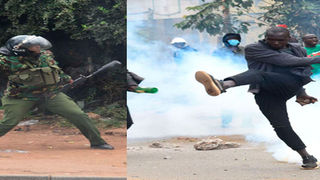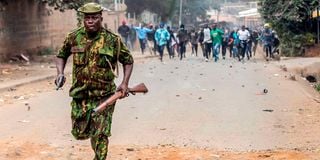
A police officer engages protesters in Kibera, Nairobi, on July 19. It remains unclear what shape dialogue, if resumed, will take.
| File | Nation Media GroupWeekly Review
Premium
Kenya on the edge: Calls for ceasefire as Azimio protests continue
A rare joint Page One editorial carried last Thursday by all the main newspapers and broadcast stations underlined the growing calls for an end to the violent confrontations between police and opposition demonstrations.
The editorial – published by the Daily Nation and its Kiswahili-language stablemate Taifa Leo, The Standard, and the People Daily as well as their respective television and radio channels, and also the Royal Media Services broadcast network – followed on the call for peace issued by the Kenya Conference of Catholic Bishops on Wednesday, day one of the three straight days of demonstrations against the high cost of living called by the opposition Azimio la Umoja coalition.
The significance of the editorial was that it was the first such joint initiative by the Kenyan media since the common Page 1 Leader at the height of the 2007-2008 post-election violence.
The various statements last week amplified calls by other religious groups and western envoys accredited to Kenya for an end to the violent protests and the equally violent police response, and highlighted the need for President William Ruto and opposition leader Raila Odinga to reach a truce and enter dialogue for a peaceful resolution of issues.

A protester holds a tear gas canister next to a bonfire in Shabab area, Nakuru City, during an anti-government protest on July 19, 2023.
The renewed calls for an end to the violence came as both sides claimed victory on day one of what has been described as the second wave of protests first launched by Raila in March.
At the end of the day on Wednesday, Interior Cabinet Secretary Kithure Kindiki released a statement claiming that most parts of the country had remained calm and peaceful, “save for isolated cases of hooliganism and breach of peace in a few spots in Nairobi, Mombasa, Kisumu, Migori, Homa Bay, Siaya and Nakuru counties, and Wote and Emali towns”, both in Makueni County.
What he did not mention is that some of the places cited were in state of virtual shutdown most of the day. Businesses remained shut, schools closed, public transport off the road and most people other than those demonstrating opting to stay indoors.
He lifted his order of the previous day issued jointly with his Education counterpart Ezekiel Machogu for schools to remain closed, an action that underlined the seriousness with which the government took the protests.
Kindiki also commended the police containing the protests “professionally and with restraint”. His statement was the polar opposite of the one released by Azimio around the same time. The press releases signed by Raila’s 2022 presidential election running-mate, Martha Karua, “noted with tremendous satisfaction the extremely successful … maandamano across the country today”. She lauded those who braved bullets, teargas and water cannons to express their stand against punitive taxes, accusing the police of unleashing unwarranted violence on “peaceful and unarmed demonstrators”.
And speaking in Kericho, Ruto again criticised the demonstrations but said he remained ready to talk on issues affecting Kenyans, though he ruled out any discussion of power-sharing deals.
Only a few days earlier, Raila had denied for the umpteenth time that he was pursuing any power-sharing or ‘handshake’ arrangement, an accusation that seems to have become an obsession of Ruto’s Kenya Kwanza grouping, though no evidence of such designs has ever been tabled.
Ruto maintained a busy working day as if to demonstrate that it was business as usual despite the opposition protests. In the morning, he hosted at State House a delegation of visiting United States Trade Representative Katherine Tai, before heading to Kericho County, where re-commissioned the stalled Kimugu Water Project.

A protester pleads with police after being arrested by police along Joseph Kang'ethe Road in Kibra, Nairobi, on July 19, 2023.
He also addressed roadside rallies, where he recalled his previous gesture of holding out an olive branch to Raila which resulted in formation of a bi-partisan Parliamentary committee to iron out issues. Instead, he said, Raila had opted to walk out of the talks and resume protests.
He asked the police to act firmly with anyone out to cause problems, adding that his government had no problem with constitutional provisions on demonstrations, “but we cannot be a country of chaos, violence … anarchy”.
Ruto did not directly address the calls for peace, but he will surely have noted the growing clamour directed at both him and Raila to “Save our Country” as all newspaper headlines trumpeted on Thursday.
It is not clear if the visiting American delegation raised the Kenyan situation with the President, but questioned by journalists, Ms Tai indicated support for the joint statements issued the previous day by US ambassador Meg Whitman and 12 other envoys from western nations including Britain, Germany, Canada, Netherlands, Sweden and Switzerland calling for peaceful resolution of the current crisis.
Tai noted, however, that the US supports freedom of speech, association and expression, and specifically in regard to the demonstrations in Kenya. While Ruto was very visible, Raila, who is the driving force behind the protests, remained out of sight.
Just like happened on the July 7 Saba Saba demonstrations, he did not put in any appearance as thousands of demonstrators heeded his call to turn out. He was absent at the press conference called by the Azimio leadership on the eve of the protests, and another briefing on Thursday.
The top Azimio leadership – Raila, Karua, former Defence CS Eugene Wamalwa, former Kakamega Governor Wycliffe Oparanya, former Murang’a Governor Mwangi wa Iria and former MP Jeremiah Kioni – were all conspicuous absentees as their supporters battled police on the streets of Nairobi, Kisumu, Mombasa, Kisii and other towns.
In most of the past demonstrations, Raila and his key lieutenants have been on the frontline, taking their doses of police teargas and high-pressure water jets, but they seem to have adopted a different strategy of staying behind the scenes.
On Saba Saba, the no-show was explained as due to intelligence information that police intended to infiltrate the demonstrations to unleash chaos.

A Kenya Police Officer runs away from a group of opposition supporters chasing him and throwing stones during anti-government protests in Nairobi on July 19, 2023.
Last week, Raila’s colleagues charged that the police had established a special unit to carry out executions of targetted opposition leaders.
There may also have been fear of arrests, as evidenced by a sweep in which a number of demonstration planners and key Raila aides were held on Tuesday night and Wednesday morning. Meanwhile, it remains to be seen whether Ruto and Raila will positively respond to the calls for peace and dialogue.
The government, through Foreign Affairs CS Alfred Mutua, has already reacted angrily to a statement by the Office of the United Nations Committee of Human Rights, blaming the police for excessive use of force.
Azimio, in turn, has faulted the US, Britain and other countries that claim to defend human rights for remaining largely silent in the face of evidence that almost all the killings recorded since the protests started have been attributed to police bullets rather than to violent demonstrators.
It is likely that even if there are moves towards talks, the Raila team will demand an inquest into police killings as one of the conditions.
On Tuesday, for instance, video and photographs spread widely on social media of plainclothes police officers firing bullets into crowds and in some cases seeming to execute captured demonstrators by shooting them at point-blank range when already subdued.
Meanwhile, it remains unclear what shape dialogue, if resumed, will take. The Ruto camp would probably be happy with resumption of the bi-partisan committee in Parliament, but that was a mechanism Azimio was not from inception comfortable with.
Raila had always preferred talks outside the confines of Parliament, and that is what he will probably insist on, together with presence of neutral mediators. It is also unclear what any talks would be about, given the fluid and ever-shifting nature of Azimio’s demands.
The protests began as pressure for scrutiny of the 2022 presidential election count servers following alleged whistleblower evidence that Raila was the actual winner.
To that was added demands for a halt to filling of vacancies in the Independent Electoral and Boundaries Commissions until all interests were accommodated. There were also secondary demands to address the rising cost of living.
‘Open the Server’ demands have since largely been pushed to the background as cost of living issues took center-stage following passage of the Finance Bill that galvanised public discontent with what was seen as excessive taxation, doubling of VAT on petrol and imposition of an unpopular Housing Fund.
To that has been added what can only be described as, if public statements from Azimio leaders are anything to go by, an attempt to topple the government through ‘people power’. That is something on which Ruto obviously will not compromise. But he can make some gestures which could persuade Azimio to at least suspend demonstrations pending establishment of a dialogue mechanism.

A protester pleads with police after being arrested by police along Joseph Kang'ethe Road in Kibra, Nairobi, on July 19, 2023.
One, suggested by the Catholic Bishops, would be for Ruto to repeal, or at least suspend implementation of the Finance Act. There will be the argument that the President has no powers under any law to repeal an Act of Parliament but the Bishops, pointedly, also asked for respect for Court Orders.
The government has so far defied a High Court order for suspension of the Finance Act pending conclusion of a suit filed by Busia Senator Okiya Omtatah.
The Kenya Kwanza government was elected partly on the pledge to respect court orders, in contrast to the previous government led by President Uhuru Kenyatta. It might not be asking too much for Ruto to at live up that promise.





